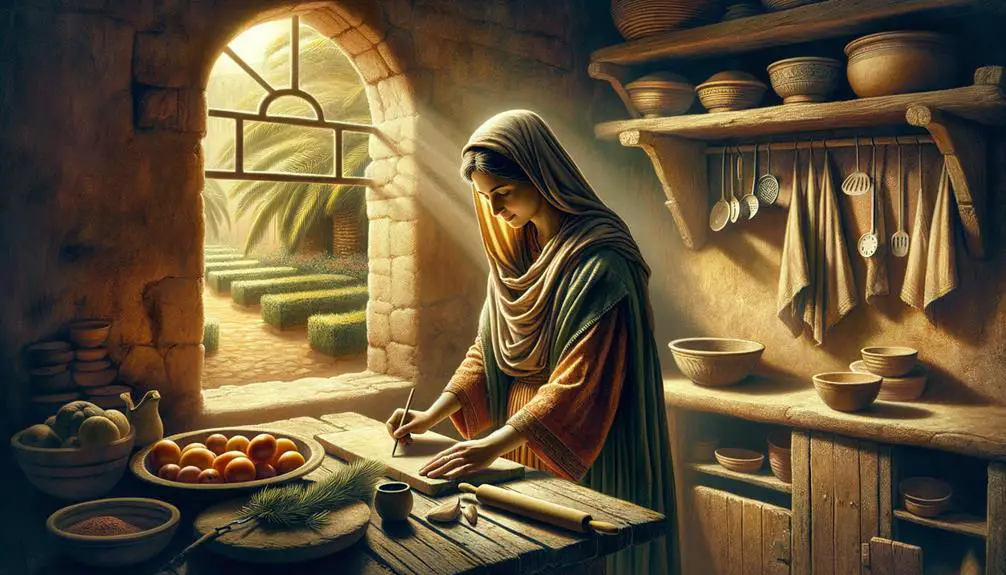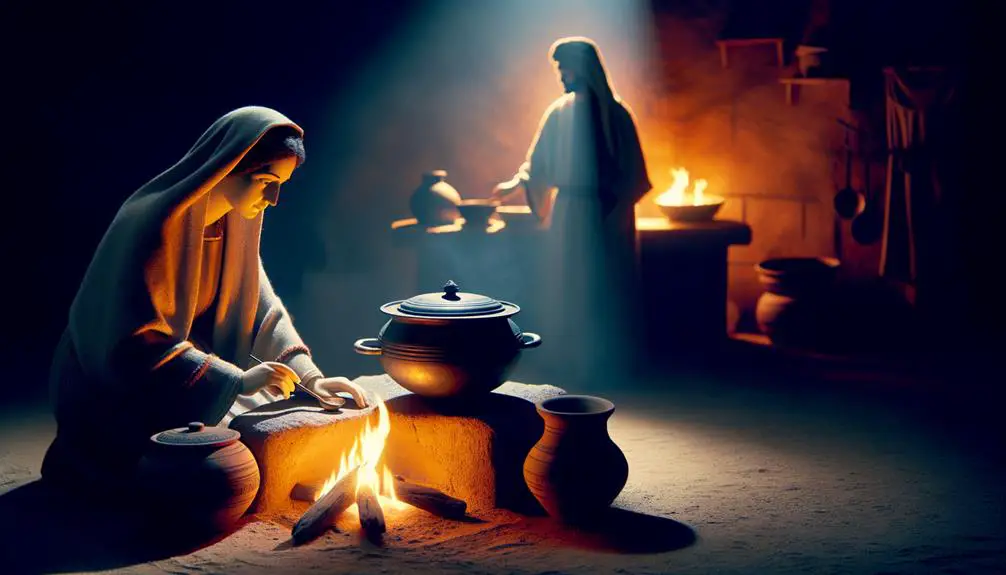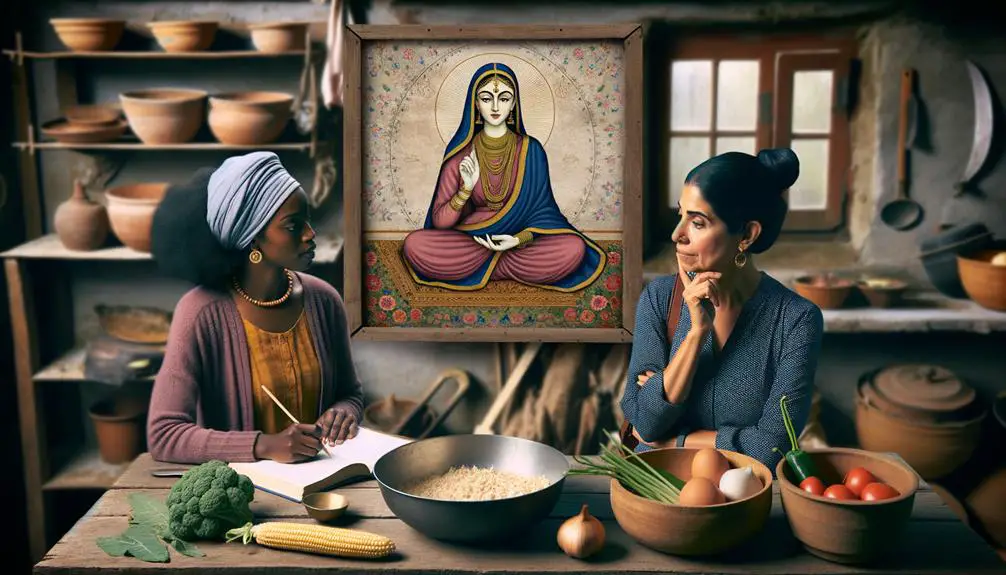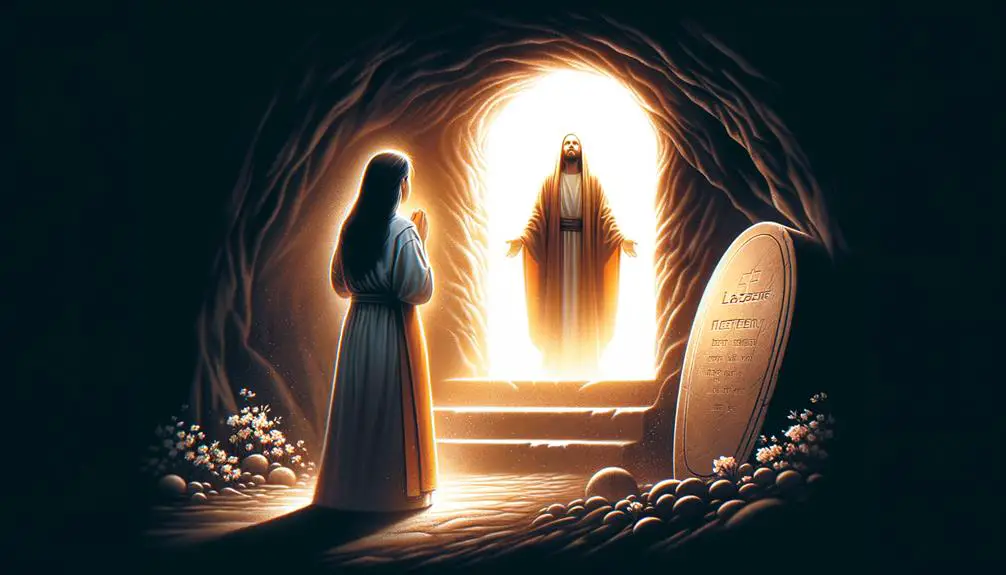Navigate Martha's biblical journey, a tale of faith and service, to uncover lessons that resonate beyond the dishes and into the heart.

Who Was Martha in the Bible
In the grand, celestial scheme of things, you might say Martha was the Bible's unsung heroine of hospitality, always stuck with the dishes while the others got the divine revelations.
You've probably heard her story, tangled up with her sister Mary and Jesus, showcasing a domestic drama that unfolds into a profound spiritual lesson.
But there's more to Martha than just being the patron saint of the stressed and overworked. Her encounters with Jesus reveal layers of faith, devotion, and humanity that often go unnoticed.
So, why should you give Martha another thought? Because her story might just change the way you view service, priorities, and faith itself.
Key Takeaways
- Martha is a biblical figure known for her role as a caregiver and hostess, displaying generous hospitality.
- Her narrative highlights the tension between societal expectations of service and personal spiritual fulfillment.
- Jesus' interaction with Martha emphasizes the importance of spiritual concerns over material duties.
- Martha's story reflects her faith evolution, becoming a symbol of personal transformation and theological engagement.
Martha's Biblical Context

Martha's narrative unfolds within the context of first-century Judea, a period marked by complex socio-religious dynamics that significantly shaped her interactions and role as depicted in the New Testament. You're delving into a time when family lineage and sibling dynamics were pivotal to one's social standing and daily life, aspects that are crucial to understanding Martha's story.
Martha's lineage, though not exhaustively detailed in scripture, positions her within a household that apparently held some level of societal respect and means, given the hospitality she and her siblings extended to Jesus. This hospitality, a valued virtue, indicates a household capable of such generosity, hinting at their social standing. You can't overlook the significance of Martha being mentioned by name; in a patriarchal society, this detail underscores her importance or distinct role within her family and community.
The sibling dynamics within Martha's story are particularly telling. As the sister of Mary and Lazarus, Martha's interactions reveal a family deeply involved in the early Christian community, providing a base for Jesus's ministry in Judea. Martha's role often seems to be that of the caregiver or the one tasked with the responsibilities of hosting, a role that speaks volumes about her character and the expectations placed upon her. Her interactions with her siblings, especially the contrast between her and Mary's approach to Jesus's visits, highlight the diversity of roles and attitudes within the same family, reflecting broader societal and religious norms of the time.
Understanding Martha within this context of lineage and sibling interplay sheds light on the broader socio-religious fabric of first-century Judea, making her more than a mere biblical character, but a window into the era's complexities.
Martha's Encounter With Jesus
You'll find Martha's encounter with Jesus to be a pivotal moment, revealing her hospitality challenge and Jesus' response with comforting words.
This interaction underscores the tension between societal expectations of service and the pursuit of spiritual fulfillment.
Analyzing this episode allows you to appreciate the depth of Jesus' message and Martha's position within her social and religious context.
Martha's Hospitality Challenge
During Jesus' visit to her home, Martha faced the challenge of balancing her role as a hostess with the desire to learn from her guest, illustrating the tension between active service and reflective listening in spiritual life. Her struggle embodies the broader cultural norms and guest expectations of her time, where hospitality wasn't just a virtue but a sacred duty.
Martha's dedication to her duties reflects the societal pressure to excel in hospitality. Her frustration highlights the often overlooked emotional labor in maintaining traditional roles. The scene underscores the internal conflict between fulfilling social expectations and personal spiritual growth.
This narrative invites you to empathize with Martha's dilemma, encouraging a deeper understanding of the complexities involved in navigating the expectations of both society and one's spiritual journey.
Jesus' Comforting Words
Amidst her hospitality challenge, Martha received comforting words from Jesus, an encounter that reshapes our understanding of service and spirituality. Jesus' response to Martha's plea for help not only offers emotional support but also serves as a poignant lesson on prioritizing spiritual over material concerns.
This moment highlights the importance of being present and valuing spiritual nourishment above all. Analyzing this exchange through a scholarly lens reveals modern parallels in the way emotional support is valued within communities. Jesus' approach underscores the significance of empathy and understanding in providing solace, principles that remain central in contemporary discussions on emotional well-being.
Thus, Martha's interaction with Jesus offers profound insights into the balance between service to others and spiritual self-care, a balance that's still sought after in today's fast-paced world.
The Lesson of Mary and Martha

You must understand that the narrative of Mary and Martha extends beyond a mere domestic dispute, touching upon the profound themes of balancing work and worship, and the prioritization of spiritual growth.
Through their contrasting actions, you're invited to reflect on the intricate interplay between the necessity of daily tasks and the imperative to nurture one's spiritual life.
This story serves as a pivotal lesson in the Christian doctrine, emphasizing that while service is commendable, it shouldn't overshadow the pursuit of spiritual enlightenment and connection with the divine.
Balancing Work and Worship
How does one navigate the delicate balance between work and worship, a dilemma poignantly illustrated through the biblical narrative of Mary and Martha? The story encapsulates the tension between fulfilling one's duties and embracing moments of spiritual reflection. This account serves as a foundational lesson in achieving work-life balance and refining worship practices for modern believers.
- The narrative underscores the importance of mindfulness in daily routines, urging individuals to not let the pursuit of productivity overshadow spiritual nourishment.
- It highlights the value of presence over busyness, advocating for a harmonious blend of action and contemplation.
- The story catalyzes a reevaluation of priorities, prompting a reassessment of how one allocates time between worldly responsibilities and spiritual pursuits.
In dissecting this biblical story, one gains profound insights into the art of balancing work and worship, a perennial challenge in the quest for a fulfilled life.
Prioritizing Spiritual Growth
Building on the understanding of balancing work and worship, it's crucial to explore how the story of Mary and Martha teaches the importance of prioritizing spiritual growth in our lives. The narrative highlights two paths: Martha's busyness vs. Mary's attentiveness to Jesus, embodying spiritual practices over mundane tasks. This dichotomy sheds light on growth barriers that detract from spiritual depth.
Aspect |
Martha |
Mary |
|---|---|---|
Focus |
Daily tasks |
Spiritual growth |
Reaction |
Frustration |
Calmness |
Guidance Sought |
External |
Internal |
Outcome |
Missed lessons |
Enlightenment |
Analyzing these contrasts, it's evident that spiritual practices demand deliberate prioritization over daily distractions. This story underscores the transformative power of choosing growth barriers to overcome, leading to a richer, more profound spiritual journey.
Martha's Faith and Declaration
Martha's declaration of faith in Jesus, while grappling with the death of her brother Lazarus, underscores a pivotal moment of theological insight within the New Testament narrative. This scene offers you a profound look into the dynamics of faith during times of deep sorrow. Despite her doubting moments, Martha's journey reflects a faithful transformation, showcasing her evolving understanding and trust in Jesus.
At this juncture, Martha confronts Jesus with both her grief and belief, stating, 'I believe that you're the Messiah, the Son of God, who's to come into the world' (John 11:27). This declaration isn't just a testament to her faith but also serves as a critical turning point in the Gospel, enlightening readers about the true nature of Jesus.
Analyzing Martha's faith, you observe a multifaceted spiritual evolution:
- From grief to belief: Martha transitions from mourning her brother's death to expressing an unwavering faith in Jesus' power and identity.
- Doubt to declaration: Her initial uncertainty gives way to a bold, public confession of Jesus as the Messiah, marking a significant spiritual milestone.
- Personal transformation: This moment illustrates Martha's growth from a hostess preoccupied with earthly concerns to a believer asserting a profound theological truth.
Martha's journey from doubt to faith is emblematic of the Christian experience, encapsulating the struggle and eventual triumph of belief over skepticism. It's a compelling narrative that not only highlights her faithful transformation but also encourages readers to reflect on their own spiritual paths. Through Martha, you're reminded of the power of faith to transcend even the most despairing circumstances, offering hope and renewal amid loss.
The Raising of Lazarus

In the narrative of the New Testament, the raising of Lazarus stands as a testament to Jesus' divine authority, challenging believers and skeptics alike to reconsider the boundaries between life and death. You're drawn into a story where Lazarus' condition, initially described as a mere illness, quickly escalates to a fatal conclusion, leaving his sisters, Martha and Mary, in mourning. This passage not only highlights Jesus' deep emotional connections but also his mastery over life itself.
As you delve deeper, you find that Lazarus has been entombed for four days before Jesus' arrival, a detail underscoring the finality of his death in the minds of the mourners and the community. This duration surpasses Jewish beliefs of the time, which held that the soul remained near the body for three days, hoping to return. Thus, Lazarus' condition is beyond hope in the eyes of those who stand by, making the subsequent events all the more miraculous.
The tomb revelation becomes the focal point, illustrating a dramatic shift from despair to awe. Jesus' command to remove the stone covering the tomb's entrance meets initial resistance due to the inevitable decomposition odor, a stark reminder of the reality of death. Yet, what follows is a profound demonstration of power and authority as Jesus calls Lazarus forth, alive, from the grave. This moment doesn't just challenge the witnesses' understanding of death but also serves as a pivotal sign of Jesus' identity and mission, inviting you to explore the depths of faith, the meaning of resurrection, and the promise of life beyond death.
Martha's Legacy and Interpretations
Reflecting on the remarkable account of Lazarus' resurrection, one must also consider how Martha's role in this and other biblical narratives has shaped her enduring legacy and the diverse interpretations of her character. Martha's character emerges not just as a backdrop to the miraculous but as a pivotal figure in her own right, embodying themes of faith, action, and devotion.
From a scholarly standpoint, the analysis of Martha's character has evolved, particularly under feminist perspectives. These interpretations highlight Martha's assertiveness and her direct communication with Jesus as indicative of a role that transcends traditional domestic confines. Such readings argue for a reevaluation of Martha, seeing her not as merely preoccupied with the domestic sphere but as engaging actively in theological discourse.
The examination of Martha's character through these lenses yields several emotive insights:
- Empowerment: Martha's assertiveness in speaking her mind to Jesus reflects a strength that resonates with many, advocating for a view of biblical womanhood that's both strong and engaged.
- Complexity: By considering her actions and words, one appreciates the depth of Martha's faith and her multifaceted role within the biblical narrative.
- Inspiration: Martha's story serves as a source of inspiration, showcasing how faith and action are intertwined in the pursuit of understanding and engaging with the divine.
Frequently Asked Questions
How Is Martha Represented in Non-Canonical Texts or Apocryphal Writings?
In non-canonical texts or apocryphal writings, you'll find Martha portrayed differently, often influenced by Gnostic perspectives. These texts delve deeper into Martha's miracles, highlighting her spiritual strength and pivotal role in Gnostic narratives.
Unlike the canonical Bible, where her role is more subdued, these writings offer a detailed, analytical exploration of her character, showcasing her as a prominent figure with profound spiritual insights and miraculous capabilities.
In What Ways Has Martha Been Depicted in Art and Literature Throughout History, Outside the Biblical Narrative?
In art and literature, you'll find Martha's depictions extend far beyond biblical texts. Artists have immortalized her in sculptures, capturing her essence in various forms and materials.
Writers and playwrights have explored her character in dramatic portrayals, offering new perspectives on her story. These interpretations, rich in symbolism and depth, reflect the complexity of her persona, illustrating how her influence has permeated cultural expressions throughout history.
Are There Any Specific Traditions or Holidays That Honor Martha in Different Christian Denominations?
Yes, Martha's feast is a tapestry woven through the fabric of Christian denominations, each thread revealing its own hue. In the Roman Catholic Church, you'll find July 29th marked as her feast day, a tradition mirrored in the Anglican Communion and Lutheran Church.
However, denominational differences arise, as the Eastern Orthodox Church honors her on June 4th and the Coptic Church on Mesra 21. These variations underline the rich, diverse celebration of her legacy across Christianity.
How Has Feminist Theology Reinterpreted or Criticized Traditional Interpretations of Martha's Role in the New Testament?
Feminist theology has critiqued traditional views on Martha's New Testament role, challenging her depiction tied to domesticity and passive service. You'll find scholars reevaluating her portrayal, emphasizing leadership qualities and discipleship, diverging from conventional gender roles.
This reinterpretation advocates for a broader understanding of women's roles in biblical narratives, positioning Martha not just in service but as an exemplar of active faith and leadership within the early Christian community.
What Are the Archaeological Evidences or Historical Findings, if Any, That Provide Insights Into Martha's Life or the Time She Lived In?
You're looking into archaeological evidence to understand Martha's personality and the era she lived in. While direct artifacts linked to her specifically are scarce, domestic artifacts from her time offer insights into daily life and women's roles.
Analyzing these items, scholars piece together a narrative that may illuminate aspects of Martha's character and environment. This approach, though indirect, helps bridge gaps in historical knowledge, providing a fuller picture of her context.
Conclusion
In conclusion, Martha's narrative in the Bible underscores the complexity of faith, service, and personal transformation. Consider the case of a modern community leader who, inspired by Martha's story, balances activism with contemplation.
This real-life example mirrors Martha's journey, highlighting how faith and action are intertwined. Martha's legacy, therefore, serves as a potent reminder that genuine faith necessitates both service and reflection, urging believers to find their own equilibrium between action and contemplation in their spiritual journeys.



Sign up